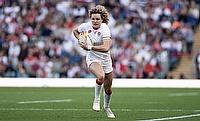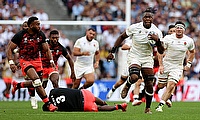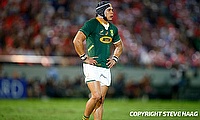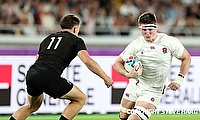England's Wings
England, as an attacking entity, made real strides forward earlier this year with their back three of Jonny May, Anthony Watson and Mike Brown.
Through the attacking renaissance of the Six Nations, the struggles of the Rugby World Cup warm-ups and then the embarrassment of a pool stage exit at their own tournament, the back three were a consistent and effective unit throughout.
May and Watson provided plenty of speed and finishing ability on the outside, whilst Brown was as safe a pair of hands at full-back as anyone in the world during that time. Their success as a group was a stark contrast to the lack of consistent selections which had bedevilled the unit over much of the last cycle.
May had come in and out of the side, switched with the likes of Jack Nowell and Marland Yarde, while Watson nailed down his starting spot earlier this year, taking it out of the hands of Chris Ashton and Semesa Rokoduguni. Brown’s selection at full-back had been more consistent, but there were still times when England toyed with Alex Goode and Ben Foden as their starting 15.
For much of that last four-year cycle, the story of England’s back three, particularly the wingers, was a lack of consistency. Inconsistent selection may not have helped, but it wasn’t the sum of the problems, with the wingers themselves enduring fluctuating form for their Aviva Premiership clubs and making it hard for then England coach Stuart Lancaster to maintain an effective back three.
The story couldn’t be more different now, with wing incumbents May and Watson having enjoyed a productive start to the season and the likes of Rokoduguni, Nowell, Yarde and Ashton all hot on their heels. Christian Wade was also in sparkling form to the start the season, although his campaign has hit a speed bump as injury has ruled him out until February.
All the wingers mentioned have passed the eye test, looking lethal with ball in hand and playing with a freedom not necessarily associated with English wingers. Beyond the eye test, the statistics speak volumes as well.
Per Opta, Rokoduguni has beaten 25 defenders in his six Premiership games so far this season, helping him to an impressive 8.4m per carry average. Fellow Bath flier Watson has beaten 15 defenders in his five Premiership games and boasts a 9.1m per carry average. It is worth noting that Watson plays at 15 for Bath and will have more opportunities per game to add easy, uncontested metres when picking the ball up from deep.
Nowell’s numbers are similarly impressive, with the versatile back chalking up 22 defenders beaten in just four games, and has a 9.2m per carry average. What’s even more impressive about those figures is that Nowell has done much of that in the tighter confines of the midfield, having represented Exeter at 13 multiple times this season.
The numbers are not quite so extravagant for Yarde (four games, 17 defenders beaten, 7.2m per carry avg), May (six games, 12 defenders beaten, 6.3m per carry avg) or Wade (four games, six defenders beaten, 7.3m per carry avg) but all three players have definitely passed the eye test, looking confident and dangerous with ball in hand.
Obviously, other factors, such as defence and not turning the ball over also need to come into the equation.
Rokoduguni has played as many games as May, and more than the rest of the wingers mentioned, yet has given up possession the least amount of times, only being turned over twice. Nowell and Yarde follow swiftly after with just three turnovers conceded, before Wade and Watson with seven and May with nine.
Tackle numbers, which need to be taken with a pinch of salt given that some teams like to blitz and others prefer to drift, also reflect favourably on Rokoduguni. The Fijian-born winger has a tackle completion rate of 88.9%, although comes second at this point to May, who has a 95% completion rate. Watson (85.7%), Nowell (85.3%) and Yarde (80%) have all done their defensive games justice, but Wade’s completion rate of 61.1% will provide ammunition to those who think he doesn’t have the defensive game to succeed at test level.
All of these statistics, not just the tackle ones, need to be treated carefully. Different teams use their wingers in different fashions and as a result, some have the opportunity to ‘pad’ those numbers with easy metres and tackles. Defenders beaten and how many turnovers they’re conceding are very useful, however.
Beating defenders is usually a result of good footwork, looking for a gap and running smart lines, whilst not conceding turnovers suggests they do not get themselves isolated and on the occasions when they do, they are able to finish the move with a try or keep themselves alive in play until support can arrive.
Whether you believe in statistics, the eye test or a combination of both, the story is unusually positive for England’s wide men heading into the 2016 Six Nations.








